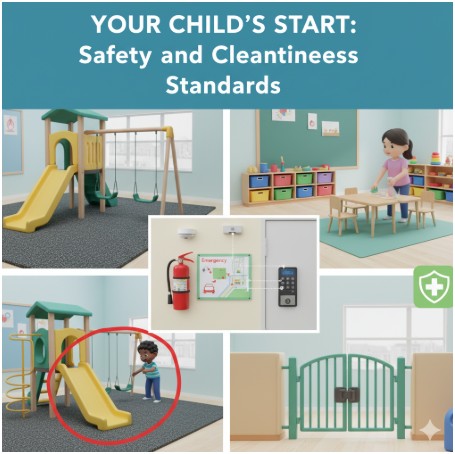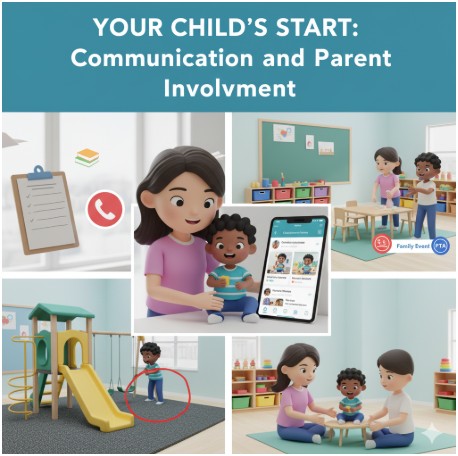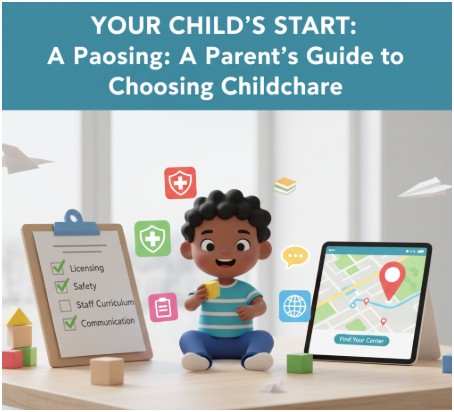Choosing a childcare center is a key decision that affects a child’s early learning, social development, and daily routine.
Tours provide valuable insights beyond brochures, letting parents observe the environment, meet caregivers, and understand the center’s philosophy.
This guide highlights key points to help parents make informed choices for their child’s growth and peace of mind.
So, What to Look for When Touring a Childcare Center?
Licensing and Accreditation
Before scheduling any tours, verify that the childcare center holds current state licensing. Licensed facilities must meet minimum health, safety, and educational standards set by government regulations. Request to see their license during your visit—it should be prominently displayed.
Beyond basic licensing, look for additional accreditation from recognized organizations like the National Association for the Education of Young Children (NAEYC) or your state’s quality rating system. These voluntary certifications indicate the center exceeds minimum requirements and demonstrates commitment to high-quality care.
Ask about recent inspection reports and whether the facility has faced any violations. Reputable centers will readily share this information and explain any corrective measures they’ve taken.
Safety and Cleanliness Standards

Your child’s physical safety should be the top priority during any childcare tour. Observe whether the building appears well-maintained both inside and outside. Check for secure entry systems that prevent unauthorized access while allowing easy evacuation during emergencies.
Examine playground equipment for proper installation, age-appropriate design, and adequate fall surfaces like rubber mats or wood chips. Indoor spaces should be free from hazards such as exposed cords, broken toys, or unsafe furniture arrangements.
Cleanliness reflects the center’s attention to detail and commitment to children’s health. Notice whether surfaces appear regularly sanitized, toys are clean, and diaper-changing areas follow proper hygiene protocols. The facility should have clear policies for illness prevention and outbreak management.
Fire safety equipment, including smoke detectors and fire extinguishers, should be visible and up-to-date. Ask about emergency procedures and how staff communicate with parents during crisis situations.
Staff Qualifications and Child-to-Caregiver Ratios
The quality of caregivers directly impacts your child’s experience and development. Inquire about staff educational backgrounds, training requirements, and ongoing professional development opportunities. Many states require specific early childhood education credentials for lead teachers.
Pay attention to staff turnover rates, as frequent changes can disrupt children’s sense of security and attachment. Centers with stable, experienced teams typically provide more consistent care and better understand individual children’s needs.
Child-to-caregiver ratios vary by age group and state regulations, but lower ratios generally mean more individualized attention. For infants, ratios should not exceed 4:1, while preschoolers can function well in groups up to 10:1 with qualified supervision.
Observe how staff interact with children during your visit. Look for warm, patient responses to children’s needs and age-appropriate communication styles. Staff should appear genuinely engaged rather than merely supervising from a distance.
Curriculum and Educational Environment
Effective childcare centers balance structured learning with free play, supporting children’s cognitive, social, and emotional development. Ask about the curriculum framework they follow and how they adapt activities for different developmental stages.
Examine the learning materials available in each classroom. Quality programs offer diverse options including books, art supplies, building blocks, dramatic play items, and age-appropriate technology. Materials should be organized accessibly for children and rotated regularly to maintain interest.
Notice whether the daily schedule provides variety while maintaining predictable routines that help children feel secure. Successful programs incorporate outdoor time, quiet activities, group learning, and individual exploration.
For preschools like those in Kaysville, ask how they prepare children for kindergarten readiness through pre-literacy, numeracy, and social skills development. However, avoid programs that emphasize academic drilling over developmentally appropriate play-based learning.
Communication and Parent Involvement

Strong partnerships between families and childcare providers benefit children’s overall development. During your tour, ask about communication methods the center uses to keep parents informed about daily activities, milestones, and any concerns.
Many modern facilities use apps or online platforms that share photos, learning updates, and care reports throughout the day.
Others rely on daily written summaries or regular phone calls. Choose the communication style that works best for your family’s preferences and schedule.
Inquire about opportunities for parent involvement, such as volunteer opportunities, family events, or advisory committees. Centers that welcome parent participation typically demonstrate transparency and value family input in their programs.
Ask about their policy for handling conflicts or concerns. Professional childcare providers should have clear procedures for addressing parent questions and resolving issues constructively.
Conclusion
When choosing a childcare center, tour multiple facilities, compare them, and trust your instincts. Prioritize quality, safety, and your child’s happiness, alongside practical considerations like location, hours, and cost.
If possible, arrange follow-up visits or trial days. The best center will match your family’s values, fulfill your child’s needs, and offer a nurturing environment, ensuring a confident decision.




